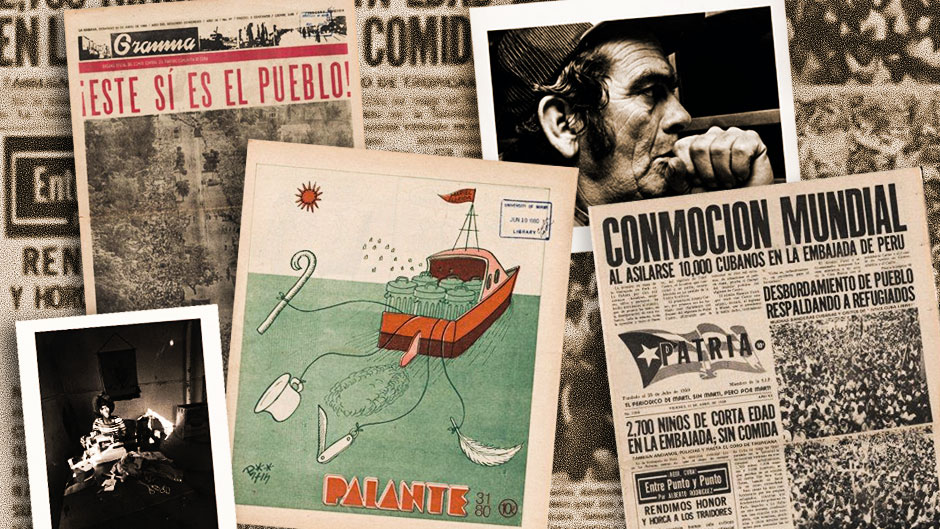The Mariel boatlift changed the face of Miami.
More than 125,000 refugees arrived from the Port of Mariel in Cuba after Fidel Castro opened the gates. Most of the refugees settled in South Florida. Unlike other Cuban migrations, this one brought a wide cross-section of Cuban society, including Afro-Cubans, artists, and members of the LGBTQ community.
The Cuban Heritage Collection (CHC) of the University of Miami Libraries possesses many holdings about the boatlift that can help students, scholars, and members of the community gain insight into this unprecedented event.
“Mariel is one of the most important and consequential historical events in the context of late Cold War relations between Cuba and the U.S.,” said Elizabeth “Liz” Cerejido, director of CHC and Esperanza Bravo de Varona chair. “I see it as a tangled knot around which many strands of historical, social, economic, and racial facts become intertwined.”
In order to understand the exodus of Mariel, “many perspectives must be taken into account,” Cerejido explained.
“Beyond the stories of those who made that perilous journey, there are countless narratives from a myriad of perspectives that also tell the Mariel story,” she added.
Many of those perspectives can be found in the various holdings that the CHC possesses on the flotilla and its impact. They include the following.
The Fort Chaffee Collection (1980-1996) was probably one of the most important holdings on Mariel because of the ways that it brings together the various aspects that defined this historical moment. In this case, it does so through the specific lens of life in a detention center in Fort Chaffee, Arkansas, where 19,000 refugees were detained. It comprises two donations. One is from Barbara Lawson, who was then the director of the Cuban-Haitian Task Force, and the other from Gastón A. Fernández, author of “The Mariel Exodus, Twenty Years Later: A Study on the Politics of Stigma and a Research Bibliography.” The collection is made up of photographs, correspondence, government documents, and more, which provide insight into many aspects of what life was like at the detention center. It also includes a series of beautiful and poignant black and white portraits of individual detainees—taken by photographer Jim Caletta—which depict the human side of the crisis. Researchers also have access to all the editions of two newsletters that were published within the detention center: La vida nueva, created by the detainees themselves, and Crossroads, published by personnel from Fort Chaffee.
The Alberto Muller Collection contains materials that include documents and letters related to the Mariel Boatlift that were collected by Muller, a Cuban-American writer and journalist.
The Mirta Ojito Collection is a popular holding that is often accessed by researchers who are working on Mariel. Ojito, a Cuban-born author and journalist wrote a book, “Finding Mañana: A Memoir of a Cuban Exodus,” that details her journey in the Mariel boatlift when she was a teenager. The collection contains her papers and documents. Ojito has promised to add to her collection.
The Luis J. Botifill Oral History Project is an accumulation of taped sessions with prominent Cuban-born personalities, four interviews with Cuban exiles who played a pivotal role in the Mariel exodus. They are banker Bernardo Benes; post-modernist visual artist Laura Luna; anthropologist Mercedes Sandoval; and Siro del Castillo, a human rights advocate and community leader on immigrant issues. During the Mariel crisis, del Castillo managed a variety of responsibilities with the county and federal government, which made efforts to manage the crisis and provide services for refugees.
The CHC also holds the full run of the magazine Mariel: Revista de literature y arte founded in New York by writers Reinaldo Arenas and Rene Cifuentes, among many other writers and intellectuals who came through Mariel. The CHC also has the papers of the magazine, which include correspondence and information about its founding. These materials are important for understanding the challenges that this generation faced in trying to publish their work and those of their peers.
Issues of a Miami version of the Mariel Magazine, published in 1986, are also part of the CHC collection. Palante, a Cuban periodical, was created in 1961 with a focus on humor and political cartoons. It is important for the ways in which the periodical relied on political satire to illustrate the rhetoric propagated by the Cuban government about those who decided to leave the country. Castro labeled them as escoria, or “scum.”
Patria is a periodical that focused on politics. Researchers working on Mariel will gain insight into the politics of the exile community in South Florida.
Researchers also have access to numerous photographs related to Mariel that are part of the broader Cuban Photograph Collection. These include color and black and white photographs of protests by members of the Cuban exile community in support of the events that took place at the Peruvian embassy in Havana and the tent city in Miami. In addition, the pictures show refugees being processed. Many of the photos were donated by Diana González Kirby.
Visit https://www.library.miami.edu/chc/ to explore the Cuban Heritage Collection’s digital collections and oral histories.

